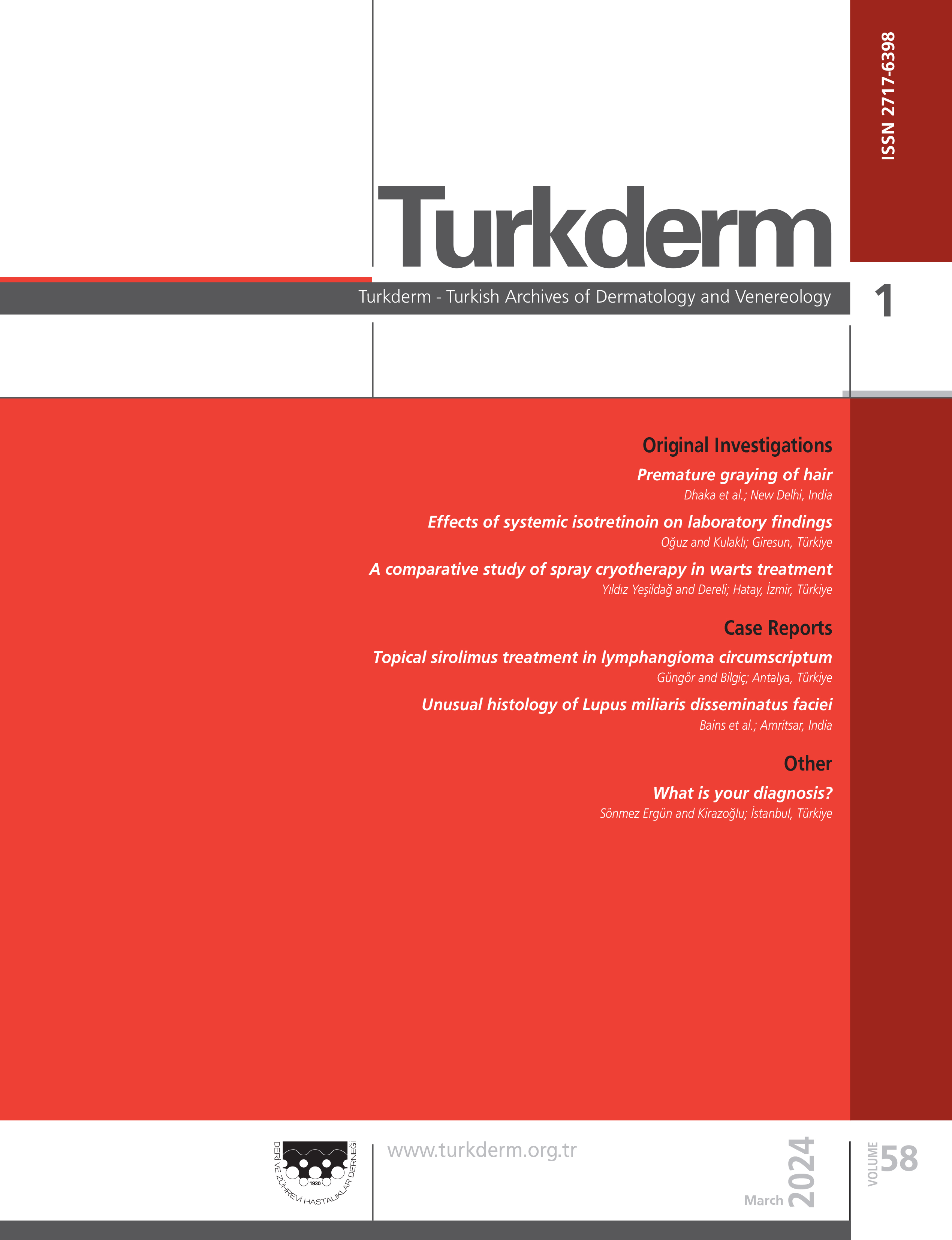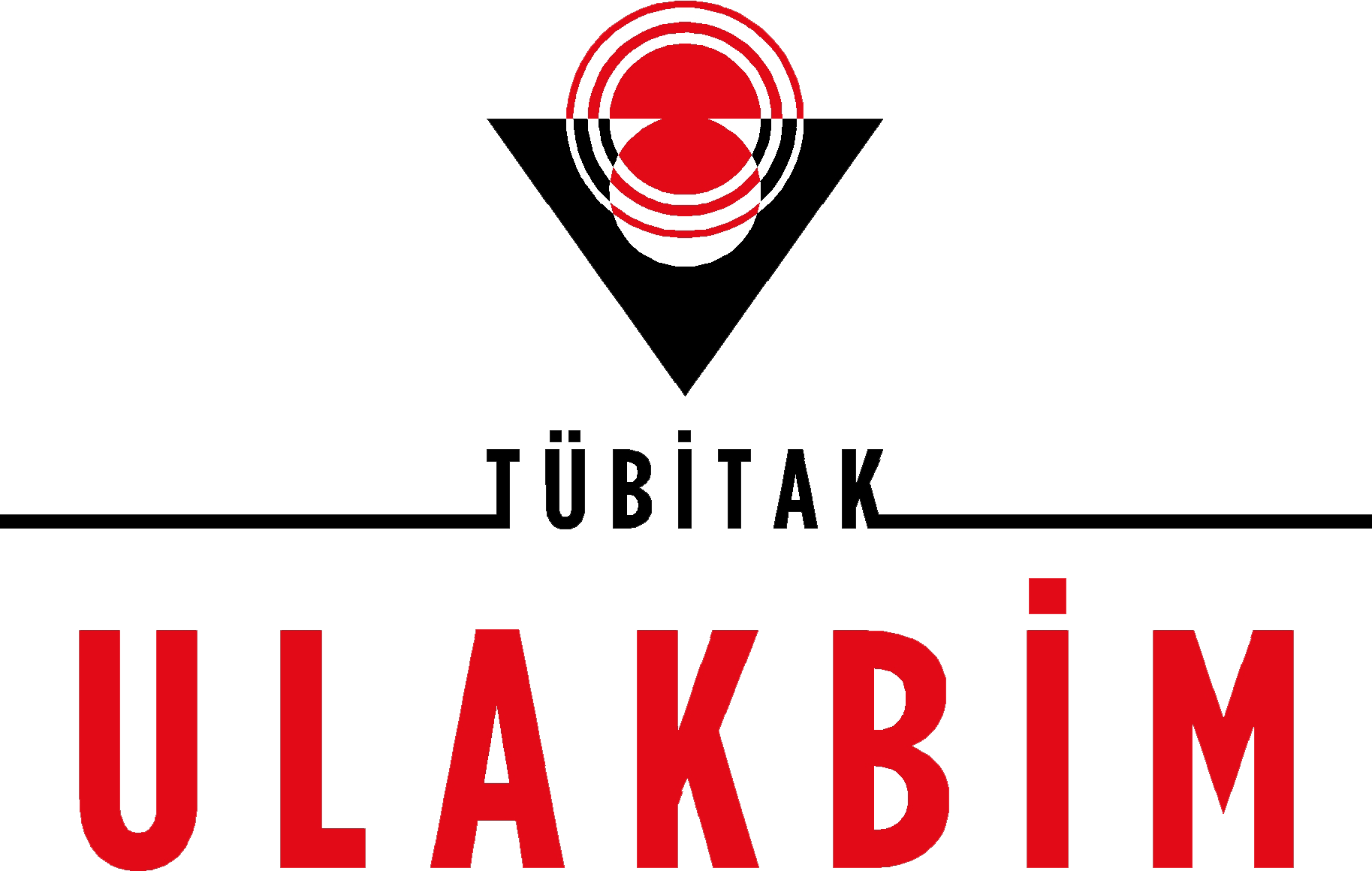Volume: 40 Issue: 2 - 2006
| EDITORIAL | |
| 1. | Dismorfizmin Çözümü Kozmetik Uygulamalar mı? Nahide OnsunPages 38 - 39 Abstract | |
| REVIEW ARTICLE | |
| 2. | Herbal therapy in dermatology Hicran Yetkin, Pınar Yüksel Başak Pages 40 - 45 Birçok deri hastalığında etkili ve güvenli olduğu bulunan bitkilerin popülaritesi gün geçtikçe artmaktadır. Son yıllarda bu konuda yapılan araştırmalar ile yeni bilgiler ve kullanım alanları ortaya çıkmıştır. Bu makalede önemli dermatolojik hastalıklarda kullanılan bitkisel tedavi seçenekleri, faydaları ve yan etkileri anlatılmaktadır. The popularity of herbal therapy found to be beneficial and safe has been increasing in several dermatologic diseases. Recent research on this subject has revealed new information and indications. In this article, herbal therapy choices used in several dermatologic diseases, beneficial and side effects have been reviewed. |
| ORIGINAL INVESTIGATION | |
| 3. | HIV/AIDS and skin: 7-year of experience at Hacettepe Gonca Boztepe, Gülşen Akoğlu, Gülşen Özkaya Şahin, Gülay Sain Güven, Serhat Ünal, Sedef Şahin Pages 46 - 51 HIV/AIDS seyrinde deri hastalıklarının normal popülasyona oranla daha sık geliştiği bilinmekle birlikte literatürde Türk hastalara ait veriler eksiktir. Bu çalışmada Mart 1998-Nisan 2005 tarihleri arasında Hacettepe Üniversitesi Tıp Fakültesi'nde takip edilen HIV/AIDS'li hastalarda deri bulguları incelenerek CD4 lenfosit sayıları ile korelasyonu araştırılmıştır. Ortanca yaşları 36 (aralık 8-80 yaş), en sık rastlanan olası bulaş yolu heteroseksüel cinsel temas olan 76 HIV/AIDS hastasının 68'inde (%90) dermatolojik incelemede deri hastalığı saptanmıştır. En sık rastlanan 3 deri hastalığı sırasıyla oral kandidiyazis (%36.8), dermatofitozis (%34.2) ve seboreik dermatit (%31.6) olarak bulunmuştur. Hastalıkların CD4 lenfosit sayıları ile korelasyonu araştırıldığında hastalık başına düşen hasta sayısının azlığı nedeniyle istatistiksel olarak anlamlı bir ilişki saptanmamıştır. Bu çalışmanın sonuçları daha önceki çalışmalara benzer şekilde HIV/AIDS seyrinde hastaların %90'unda en az bir deri hastalığı gelişebileceğini ve bunun Türk HIV/AIDS hastalarında sıklıkla oral kandidiazis, dermatofitozis veya seboreik dermatit olacağını ortaya koymaktadır. Summary: Backround and Design: Data about the skin disorders that belong to Turkish HIV/AIDS patients are lacking. The aim of this study was to evaluate the frequency of the skin disorders and to search the correlation between the skin disorders and the CD4 lymphocyte counts of the HIV/AIDS patients who were being treated at the University of Hacettepe Faculty of Medicine. MATERIAL-METHODS: Between March 1998 and April 2005, 76 HIV/AIDS patients (54 female, 22 male) with a median age of 36 years (range 8-80 years), in whom the most common risk factor for transmission was heterosexual contact, were prospectively analyzed. RESULTS: At least one skin disorder was found in 68 patients (90%). The most common 3 skin disorders were oral candidiasis (36.8%), dermatophyte infections (34.2%), and seborrheic dermatitis (31.6%), respectively. Probably due to the limited number of patients with each of the certain skin diseases, a statistically significant correlation between the skin disorders and the CD4 lymphocyte counts was not found. CONCLUSION: In accordance with the previously published data the results of the current study suggest that, during the course of HIV/AIDS at least one skin disorder would be detected in 90% of the patients, and that the most common three skin disorders in Turkish HIV/AIDS patients would probably be oral candidiasis, dermatophyte infections, and seborrheic dermatitis. |
| 4. | Prolactin levels in patients with pemphigus Mukaddes Kavala, Şükran Sarıgül, Ö. Emek Kocatürk Pages 52 - 55 Prolaktinin (PRL) otoimmünite ve otoimmün hastalıklarla ilişkili olduğu gösterilmiştir. Bu çalışmada otoimmün bir hastalık olan pemfigusta serum PRL düzeylerinin hastalık ve hastalık aktivitesi ile ilişkisini saptamak amaçlandı. Pemfigus tanısı alan 40 hasta ile 44 kişiden oluşan kontrol grubunda serum PRL düzeyleri immünoassay yöntem ile ölçüldü. Hiperprolaktinemi, pemfiguslu hastalarda %10.2, kontrol grubunda %0 olarak saptandı (p=0.058). Erkek hastalarda serum PRL düzeyleri kontrol grubuna göre anlamlı olarak yüksek bulunmazken (p>0.05), kadın hastalarda anlamlı derecede yüksek bulundu (p<0.05). Aktivasyon döneminde her iki cinste serum PRL düzeyleri kontrol grubuna göre anlamlı olarak yüksek saptandı (p<0.05, p<0.01). Remisyondaki kadın ve erkek hastalarla kontrol grubu arasında serum PRL düzeyleri açısından anlamlı fark gözlenmedi (p>0.05). Bulgularımız PRL'in pemgifusun patogenezinde rolü olabileceğini ve serum PRL düzeylerinin hastalık aktivitesi ile korelasyon gösterebileceğini düşündürmektedir. Background and Design: It has been demonstrated that prolactin has an important role in autoimmunity and autoimmune diseases. The aim of this study was to evaluate the level of prolactin (PRL) in pemphigus patients and its relation with the disease and disease activity. MATERIALS-METHODS: Serum PRL levels were determined by immunoassay methods in 44 patients with pemphigus and in control group of 44 individuals. RESULTS: Hyperprolactinemia was 10.2% for pemphigus patients versus 0% for healthy controls (p= 0.058). Serum PRL levels of the male patients was not significantly enhanced compared with that found in controls (p>0.05) while the female patients' was statistically significantly increased (p<0.05). Serum PRL levels of male and female patients were significantly increased in active disease compared to control group (p<0.05, p<0.01). Also no significant difference was detected between serum PRL levels of both sexes in inactive disease compared to control group (p>0.05). CONCLUSION: Our findings suggest that PRL may play a role in the pathogenesis of patients with pemphigus and there may be a correlation between serum PRL levels and disease activity. |
| 5. | Prurigo pigmentosa: could it be more common than it is thought Aslı Altaykan, Gonca Boztepe, Sedef Şahin, Deniz Duman, Özay Akkaya, Gül Erkin Pages 56 - 59 Prurigo pigmentoza (PP) Japonya'da sık rastlanan ve etyolojisi bilinmeyen bir hastalıktır. Japonya dışındaki vakaların çoğu Akdeniz ülkelerinden bildirilmiştir. Bu çalışmada prurigo pigmentozanın klinik ve histopatolojik bazı özelliklerinin belirlenmesi amaçlandı. Bu amaçla Hacettepe Üniversitesi Tıp Fakültesi ve Acıbadem Hastanesi Dermatoloji Poliklinikleri'ne başvuran klinik ve histopatolojik olarak prurigo pigmentoza tanısı almış, yaşları 18-41 yaş arasında değişen 7 hastanın verileri retrospektif olarak değerlendirildi. Histopatolojik örnekler Böer ve arkadaşlarının tariflerine göre evrelendirildi. Tümü yoğun kaşıntı ve lekeler bırakan döküntü yakınmasıyla başvuran hastaların dermatolojik incelemelerinde gövde ön yüz, sırt ve boyunda yerleşen eritemli papüller ve retiküler hiperpigmentasyon saptandı. Hastaların tümünde birden fazla evreye ait histopatolojik özellikler bir arada izlendi. PP halen nadir rastlanan bir hastalık olarak kabul edilmektedir, ancak vakalarımız, şimdiye kadar Türkiye'den bildirilen diğer vakalar ile birlikte değerlendirildiğinde, prurigo pigmentozanın Türkiye'de sanılandan daha sık gözlendiğini düşündürmektedir. Histopatolojik bulgular hastalığın oldukça dinamik bir süreç olduğunu desteklemektedir. Background and Design: Prurigo pigmentosa (PP) is a common disease in Japan. Most reports other than those from Japan include Mediterranean countries. The aim of this report was to determine clinical and histopathologic features of seven cases seen in our outpatient clinics. MATERIALS-METHODS: Data that belong to 7 patients (6 female, 1 male), age range 18-41, who had been administered to outpatient clinics of Hacettepe University Faculty of Medicine Deparment of Dermatology, and Acıbadem Hospital between 1998-2003, and had been diagnosed as PP clinically and histologically was retrospectively evaluated. Histopathologic findings were classified as suggested by Böer et al. RESULTS: All patients complained about intense pruritus and pigmentation, and presented clinically with erythematous papules and reticular hyperpigmentation on the chest, back, and neck. Histopathological findings in all patients included features that belong to more than one stage. CONCLUSION: Although PP is accepted as a rare disease, when the patients presented here, and those previously reported from Turkey are taken into consideration, we suggest that PP might be more common than its supposed frequency in Turkey. The histopathological findings support that the disease has a quite dynamic process. |
| 6. | Systemic drugs in the etiology of recurrent aphthous stomatitis Ulviye Atılganoğlu, Özlem Su, Aslı Turgut Erdemir, Sıla Şeremet Erdoğan, Halide Ufacık Pages 60 - 62 Rekürren aftöz stomatit (RAS) oral mukozanın ağrılı, tekrarlayan ülseriyle karakterize kronik inflamatuvar bir hastalığıdır. Sık görülen ve klinik özellikleri son derece iyi tanımlanan bu lezyonların etyolojisi ve patogenezi tam olarak bilinmemektedir. RAS etyolojisinde çok sayıda faktör rol oynamaktadır. Sistemik ilaç kullanımına bağlı gelişen aftöz stomatitle ilgili olarak son zamanlarda olgu bildirimleri bulunmaktadır. Bu çalışma RAS etyolojisinde sistemik ilaçların olası rolünü araştırmak amacıyla planlandı. RAS şikayeti ile polikliniğimize başvuran 80 olgu çalışmaya alındı ve sağlıklı 80 kişi de kontrol grubu olarak değerlendirildi. Olguların klinik özellikleri belirlenerek, ilaç kullanımı sorgulandı. Çalışmamız non-steroid antienflamatuvar (p<0,01), analjezik (p<0,01), myorelaksan (p<0,01), antibiyotik (p<0,05) kullanımı ve RAS gelişimi arasında istatistiksel olarak anlamlı pozitif bir ilişkiyi gösterdi. Daha önceki olgu bildirileri ve kontrollü yapılan bir çalışma ile bizim çalışmamız non-steroid antiinflamatuvar ilaçlarla aftöz ülserler arasında gerçek bir bağlantı olduğunu düşündürmektedir. Biz beta blokerlerin rolünü saptayamadık. Çalışmaya aldığımız hastaların pek azının beta bloker kullanıyor olması bu durumu açıklayabilir. Sorumlu ilaçların kesilmesi iyileşmeyi sağlayacağından bu sonuçlardan tedavide yararlanılabilir. Background and Design: Recurrent aphthous stomatitis (RAS) is a chronic inflammatory disease of the oral mucosa that is characterized with painful recurrent ulcers. Although it is relatively common and well-defined the etiology and pathogenesis is unknown. The etiology of RAS is multifactorial. Aphthous ulcers resulting after systemic drug use have been published recently. MATERIALS-METHODS: This study is designed for searching the probable role of systemic drug use in the etiology of RAS. Eighty patients with RAS who applied to our clinic and eighty healthy persons were studied. Clinical features were determined and medications taken were questioned. RESULTS: Our study showed an association between non-steroidal antiinflammatory drugs (p<0,01), analgesics (p<0,01), myorelactans (p<0,01), antibiotics (p<0,05) use and RAS. CONCLUSION: Previous case reports, a case control study and our study suggest a real link between non-steroidal antiinflammatory drugs and aphthous ulcers. Our study did not confirm a role of beta-blockers. The reason of this result may be the limited number of patients who were using these drugs.. All these data could be beneficial for treatment of patients with RAS, as healing may occur when the responsible drugs are discontinued. |
| SURGICAL PEARLS | |
| 7. | Plastic tube method for ngrown toenail: preliminary study Gonca Boztepe, Ayşen Karaduman, Nilgün Atakan Pages 63 - 65 Tırnak batması sık karşılaşılan, standart tedavisi olmayan dermatolojik bir sorundur. Bu ön çalışmanın amacı, tırnak batması tedavisinde bilinen ve basit bir cerrahi yöntem olan plastik tüp yönteminin hatırlatılması ve bölümümüzde bu yöntemle elde ettiğimiz ilk verilerin değerlendirilmesiydi. Şubat 2005-Haziran 2005 tarihleri arasında ayak başparmağında tırnak batması olan, 12 hastanın, 17 tırnak kenarına plastik tüp yerleştirildi. Plastik tüp 3-6 hafta sonunda tırnak kenarından çıkarıldı, ve hastalar tüp çıkarıldıktan sonra ortalama 3.1 ± 1.0 ay süreyle nüks açısından takip edildi. Uygulama yapılan hastaların tümünde girişimden hemen sonra ağrı ortadan kayboldu. Uygulama sırasında ve sonrasında herhangi bir komplikasyon gelişmedi. Takip süresi sonunda 17 tırnak kenarından 2'sinde (%11.7) nüks izlendi. Sonuçlar plastik tüp yönteminin uygulamadan hemen sonra ağrıyı ortadan kaldıran, komplikasyon riski olmayan pratik bir yöntem olduğunu ortaya koymakla birlikte, çalışmaya katılan hasta sayısının sınırlı, takip süresinin kısa olması nedeniyle yöntemin tırnak batması tedavisindeki etkinliği konusunda kesin bir karara varabilmeyi mümkün kılmamaktadır. Halen devam eden bu çalışmada hasta sayısının artırılması ve nüks açısından takip süresinin uzatılması planlanmaktadır. Background and Design: Ingrown toenail is a quite common disorder, without an approved standard treatment modality. The aim of this study was to recall the previously described plastic tube method for the treatment of ingrown toenail, and to evaluate the early results we obtained with this method. MATERIALS-METHODS: During February 2005 and June 2005, plastic tube was inserted to 17 ingrown toenail sides of 12 ingrown toenail patients. The plastic tube was left at the toenail side for 3-6 weeks and the patients were followed-up for a mean duration of 3.1±1.0 months after removal of the tubes. RESULTS: Pain disappeared immediately after the procedure in all patients. No complications were observed during or after the procedure. Of 17 nail sides recurrence was observed at 2 (11.7%) nail sides. CONCLUSION: Although the results of this preliminary study suggest that plastic tube method may control pain, does not include complications, and is a safe procedure, it is not possible to make a conclusion about the efficacy of the procedure due to the limited number of patients included in this study, and short duration of follow-up. We plan to extend the number of patients, and to widen the follow-up period in this ongoing study. |
| TURKDERM-9860 | |
| 8. | Combination of 5-fluorouracil and cryotherapy in the treatment of multiple superficial basal cell carcinomas located on the trunk Fatma Aydın, Nilgün Şentürk, Levent Yıldız, Rafet Koca, Tayyar Cantürk, Türkay Yalın, Ahmet Yaşar Turanlı Pages 66 - 68 Bazal hücreli karsinoma beyaz ırkta en sık gözlenen deri kanseridir. Bazal hücreli nevüs sendromu klinik olarak çok sayıda bazal hücreli karsinoma oluşumu ve çeşitli gelişimsel anomalilerle karakterizedir. Topikal 5-Fluorourasil ve kriyoterapi, bazal hücreli karsinomanın tedavisinde kullanılan yöntemler arasındadır. Burada topikal 5-Fluorourasil ve krioterapi kombinasyonu ile başarılı bir şekilde tedavi edilen multipl bazal hücreli karsinomalı bir olgu sunulmaktadır. Basal cell carcinoma is the most common skin cancer of the white population. Basal cell nevus syndrome is characterized by the development of multiple basal cell carcinomas and various developmental anomalies. Topical 5-fluorouracil and cryotherapy are the methods that can be used in the treatment of basal cell carcinomas. Herein we report a patient with multiple basal cell carcinomas who have been successfully treated with the combination of 5-fluorouracil and cryotherapy. |
| 9. | Discoid lupus erythematosus development in a patient with antiphospholipid syndrome Sevil Gündüz, Tülin Mansur, Çağda Çelikten Öncel, Zuhal Erçin Pages 69 - 71 Antifosfolipid sendromu (AFS), arteryel ve/veya venöz tromboza yol açtığı düşünülen antifosfolipid antikorlarının oluşturduğu otoimmün bir hastalıktır. Antifosfolipid sendromu olan hastalarda birçok deri bulgusu tanımlanmıştır. Diskoid lupus eritematozus (DLE), AFS'nin nadir görülen bir deri bulgusu olarak bildirilmektedir. 2 yıldır AFS olan 22 yaşındaki erkek hasta, yüzünde gelişen eritematöz, violase ve skuamöz plakları nedeniyle polikliniğimize başvurdu. Lezyonların histopatolojik incelemesinde, DLE ile uyumlu bulgular, direkt immunfloresan incelemesinde bazal membran zonunda lineer IgG ve IgM birikintiler görüldü. Literatürde, AFS olan olgularda DLE'nin görülme sıklığı ile ilişkili bir araştırmaya rastlanmamıştır. Buna karşılık, DLE'li olgularda antifosfolipid antikorlarının değerlendirildiği birçok çalışma mevcuttur. Bu çalışmaların çoğunda, DLE'li ve subakut kutanöz lupus eritematozuslu hastalarda antikardiyolipin antikorları ve AFS bulgularının araştırılması gereği vurgulanmaktadır. Antiphospholipid syndrome (APS) is an autoimmune disorder in which antiphospholipid antibodies (APA) are thought to be involved in the development of venous and/or arterial thrombosis. Many cutaneous manifestations have been described in patients with APS. Discoid lupus erythematosus (DLE) is reported as a rare cutaneous finding of APS. A 22-year old man with a history of APS for two years has developed erythematous, violaceous and squamous plaques on his face. Histopathologic examinations showed findings consistent with DLE. Direct immunofluorescence examination demonstrated linear IgG and IgM deposition at the basal membrane zone. As far as known, there is no study about the frequency of DLE in APS patients in the literature. However there are many reports about the presence of APA in patients with DLE. Most of these studies emphasized the importance of investigations of the anticardiolipin antibodies and APS symptoms in patients with DLE or subacute lupus erythematosus. |
| 10. | A case report of two brothers with comedonal Dariers disease A. Tülin Mansur, İkbal E. Aydıngöz, Nurhan Kocaayan, Zuhal Erçin, Önder Peker Pages 72 - 74 Darier Hastalığı sıklıkla kıl foliküllerini etkileyen, esas olarak gövde ve saçlı deri gibi seboreik bölgeleri tutan, hiperkeratotik papüllerle karakterize bir genodermatozdur. Komedonal Darier hastalığı ise komedonlar ve epidermoid kist benzeri lezyonlarla belirlenen nadir rastlanan bir formdur. Literatürde bu özellikleri taşıyan 5 olgu bulunmaktadır. Bu makalede sunulan 27 ve 35 yaşlarında iki erkek kardeşte, Darier hastalığının tipik klinik bulgularına ek olarak yüzde özellikle zigomatik bölgelerde, koltuk altlarında ve sternum üzerinde çok sayıda açık ve kapalı komedonlar, yer yer sarı-beyaz renkte, yağlı içerikli kistler bulunuyordu. Bu alanlardan yapılan biyopsilerde izlenen kistik yapıların duvarını döşeyen epitelde akantoliz, yarık oluşumu ve diskeratotik hücreler, lümeninde ise lamellar tarzda keratin mevcuttu. Komedonal Darier hastalığının iki kardeşte ortaya çıkması, bu klinik varyantın gelişiminde kalıtsal veya çevresel faktörlerin rol oynayabileceğini düşündürmektedir. Darier's disease is a genodermatosis affecting mainly the hair follicles and clinically presenting as hyperkeratotic papules arising mostly on the seborrheic areas like the trunk and the scalp. Comedonal Darier's disease is a rare type which is characterized by comedones and epidermoid cyst like lesions. In the literature 5 cases having these characteristics have been reported. Here is presented two brothers with 27 and 35 years of age, exhibiting the typical clinical features of Darier's disease in addition to many open and closed comedones and whitish-yellow cysts containing oily material, which are found on the face, especially the zygomatic prominences, axillae and the sternum. Histologic examination of these lesions showed cysts with lamellar type of keratin in the lumen and acantholysis, cleft formation and dyskeratotic cells in the epithelial wall of the cyst. The presence of comedonal Darier's disease in two brothers shows that hereditary and environmental factors may play a role in the development of this clinical variant of Darier's disease. |
| NEW PUBLICATIONS | |
| 11. | New Publications Page 75 Abstract | |
| TURKDERM-6637 | |
| 12. | Society News Pages 76 - 77 Abstract | |
| 13. | Kongre Takvimi Page 78 Abstract | |






















